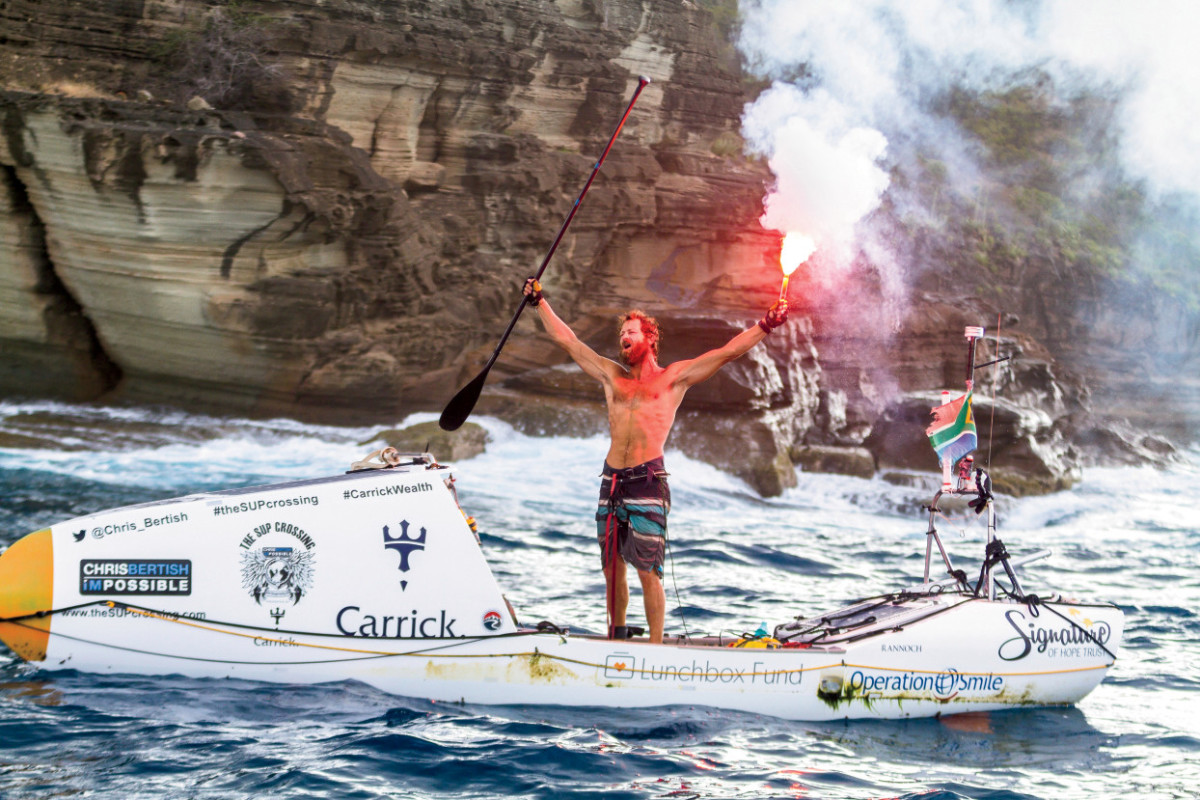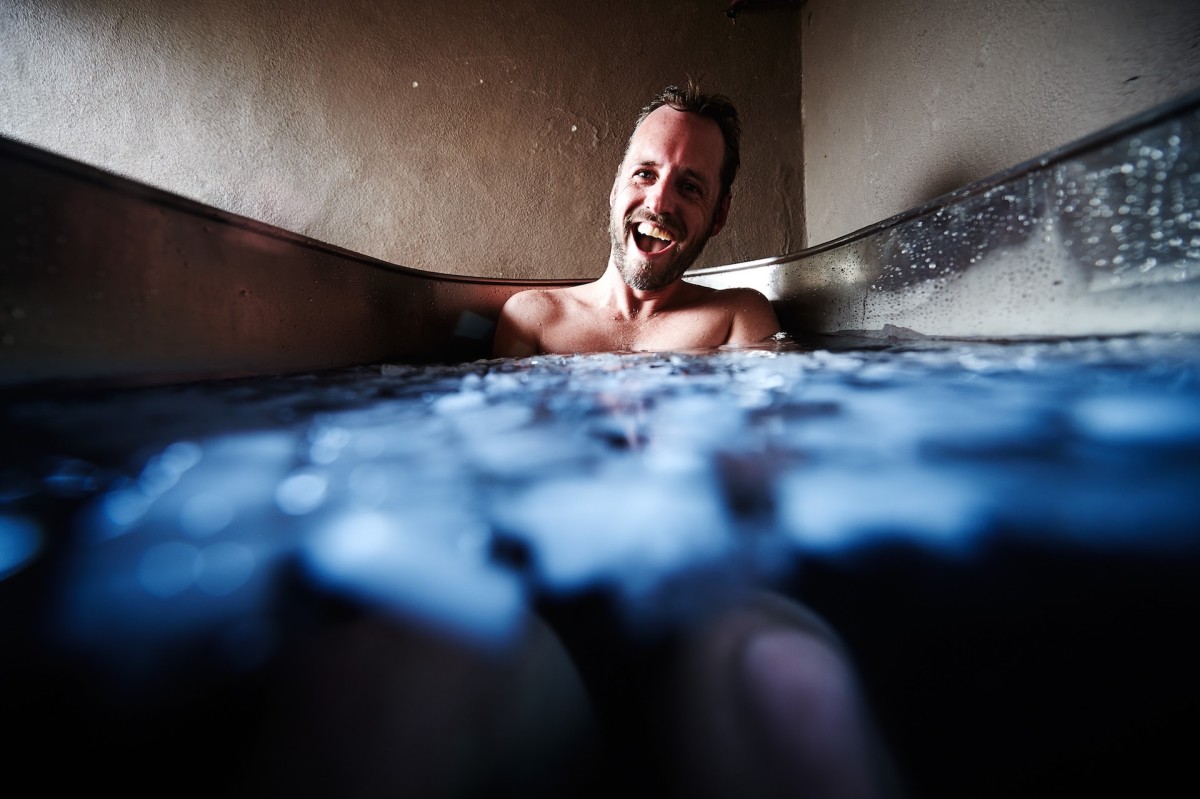“For me to excel at something, it has to be intense,” Jeff Denholm tells me over the phone after completing a 30-minute stationary swim in southern Oregon’s Rogue River. Salmon swam past Denholm, 54, as he took one stroke after the other, grabbing the water with his left hand and following up with his right, where instead of his biological arm—which got torn off in an accident—he’s fit with a prosthetic carbon fiber paddle.
Denholm lost his arm at his shoulder while on a commercial fishing vessel in Alaska in 1993. A powerful wave smacked into the boat and threw him off balance while he was in the engine room repairing equipment. When he fell over, the driveshaft pulled in his outstretched arm, the inward drag splintering his arm, fracturing his collarbone, and breaking his neck. In such remote waters, it took 21 hours to get to a hospital. Thirty-foot waves in the Bering Sea pounded the vessel and 50-knot winds beat down on the helicopter during his extraction. Surviving the accident was his first obstacle. Months of recovery followed. For the next 27 years, he’s adapted. Arm use means a customized prosthetic to secure a paddle and other devices.
“I cried a bit after I lost my arm, but I bullied myself back,” says Denholm, who had to continue doing the adventure sports he loved. “I have a very high personal bar. No matter how far I go, I always am hungry for more. I push myself to the brink, which means sometimes taking it too far.”
“The first year after I got hurt,” Denholm adds. “I stayed with a friend in Vail, Colorado, where I skied 110 days in a row. I said ‘I am not disabled; I am an athlete.’”
Raised in York Beach, Maine, Denholm grew up playing hockey, climbing mountains, racing triathlons, skiing, and surfing. He dreamt of becoming a bush pilot and flying in Alaska; after the accident, he replaced the dream with work as a professional diver. That work led to picking up a gig on legendary undersea explorer Barry Clifford’s exploration dive team, which in 1998 discovered Captain Kidd’s 17th-century ship in Madagascar. That work reinforced his life trajectory pushing personal limits. Ever since, he’s searched for underwater hidden treasure, while continuing to ski, surf, kite board and mountain bike at a high level.
Today, Denholm resides in Santa Cruz, CA, where a short drive up the coast takes him to a secret big-wave surf break like Mavericks, but without the crowds. Big wave surfing grabbed him because it satisfies his ADHD mind. Staring down a massive wall of water he knows he has two choices: ride correctly or fall big. During a wipeout at an outer reef in Oahu during a historic swell, waves drove him 50 feet down to the ocean floor, slamming him hard enough to lacerate his feet. A 2013 tow surfing injury caused more damage; his left foot is held together with plates and screws.
“For me, with big wave surfing,” Denholm says, “it’s about the journey getting there and everything involved in preparing for it. It’s about the majesty of being in the ocean when it’s so powerful like that. That’s what I live for.”
In addition to surfing, Denholm is an accomplished paddleboarder who’s competed four times in the Molokai 2 Oahu Paddleboarding World Championships where he endured 32 miles of chaotic open water. During his first race, the glue holding his prosthetic arm to his body peeled away from his skin, forcing him to complete the final 10 miles by paddling with one arm. Exhausted, he crossed the finish line in 8 hours, 8 minutes. To Denholm, the victory was that he knew he could do it, and he would be back for more.
As he continues to push his body, injuries pile up. Three years ago, he sustained a traumatic brain injury while skiing at Squaw Valley, CA, when he collided with a friend in steep terrain, tomahawked down a cliff band, remaining unconscious for 30 minutes. Another time, he overshot the landing on a ski jump at Snowbird, UT, herniating his discs and fracturing his lumbar vertebra. “After a life of action sports, my spine has taken a beating,” he says.
“As my body has unraveled, I’ve put more focus on business—I went from being a full-time athlete to a full-time businessman. Which sucks,” he says, releasing a big laugh.
Denholm’s work life has taken its own unique path, with former careers including mariner, commercial diver, and shipboard medic. He’s also a surf ambassador for Patagonia, 1% for the Planet, and Save The Waves Coalition. And he plays a mentorship role with young adaptive surfers. “I advise on training, and I’ve talked people off the ledge, literally,” he says. “I feel it’s a calling and a duty.”
These days, he focuses on two things: leasing firefighting engines as a USFS firefighting contractor, and as founder and CEO of Atira Systems, makers of Strong Water technology, a top-performing, biodegradable, non-toxic fire suppressant.
For the last 10 years, he’s developed and produced the water technology designed to take on the mega-wildfires that are ravaging the planet (including one threatening his own California backyard, at the time of press). He’s getting inquiries from around the world including Australia, which recently made headlines for its immense firestorms (in February 2020, in New South Wales, 17 million hectares burned and 2,500 structures were destroyed). In anticipation of these new fires, he’s working with the Australian government for solutions, including using cannons to blast his fire suppressant product into firestorms.
“I’m hell-bent on getting the industry to adopt new tactics to stop these super fires,” he says. “That’s where my singular focus is. That’s been the hardest thing I’ve tried to do.”
from Men's Journal https://ift.tt/31njmpN

 @patagonia @fcdsurfboards @1percentftp @rainbowfins @savethewavescoalition
@patagonia @fcdsurfboards @1percentftp @rainbowfins @savethewavescoalition


Comments
Post a Comment